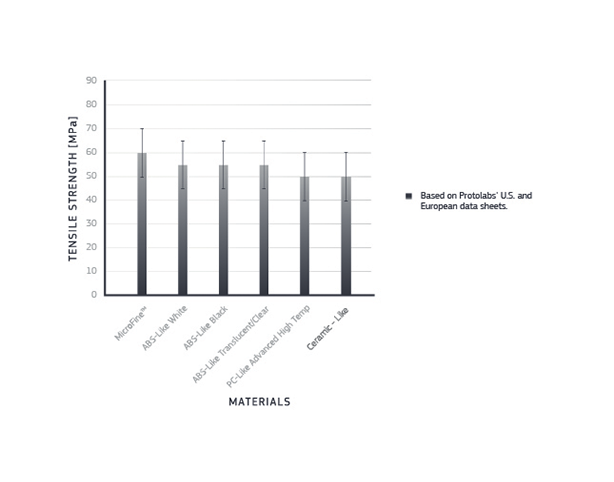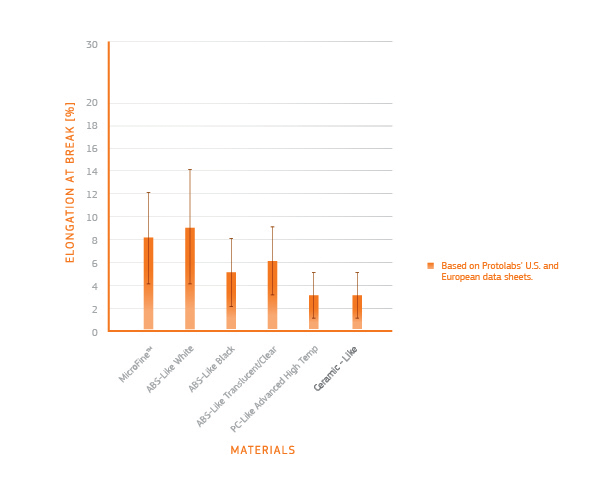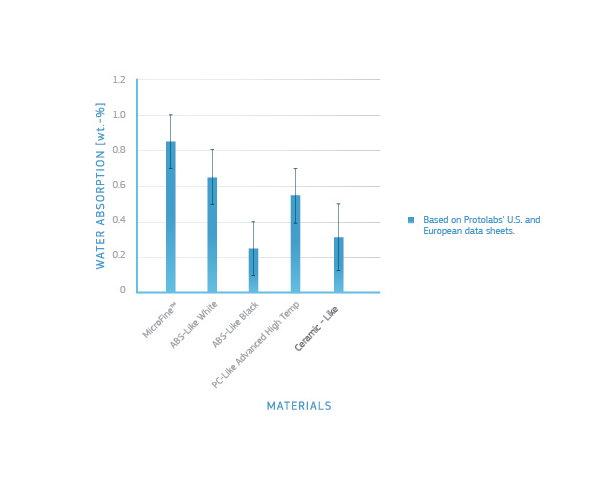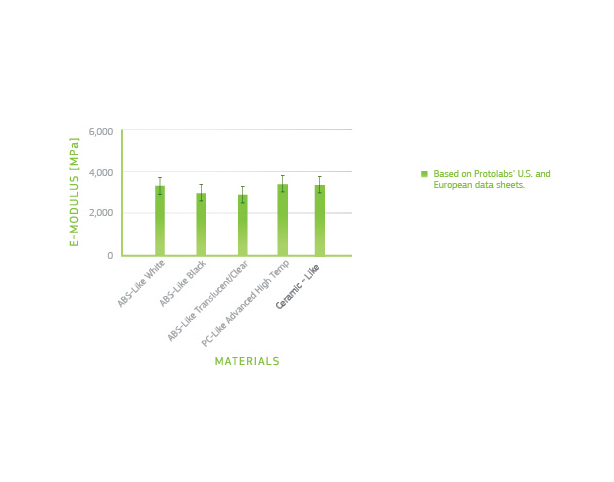Selecting a Material for Stereolithography (SLA) 3D Printing
Compare injection-moulded thermoplastics to ‘thermoplastic-like’ materials in stereolithography

Many factors come into play when comparing the material properties of thermoplastics found in injection moulding versus “thermoplastic-like” materials used in an industrial-grade 3D printing technology like stereolithography (SLA).
SLA is a plastic 3D printing process that uses a thermoset liquid, not a thermoplastic, which is UV-cured in layers to form final parts. Because of this major difference in fabrication methods, material properties like tensile strength, heat deflection, and flexural modulus may differ from SLA’s more traditional counterpart. Furthermore, SLA produces anisotropic properties where the values for X, Y, and Z axes may differ depending on the orientation of the build—a consideration unique to 3D printing processes.
Within our 3D printing service, we offer a large selection of thermoplastic-like SLA materials, but what may surprise you is the versatility and range of potential applications for SLA parts. In the tables and charts below, we’ll take you through each 3D Printing material and its properties, and compare them with one another (as well as those for moulded plastics) to help you decide how to best implement SLA.
Polycarbonate-Like Materials
PC-Like Advanced High Temp (Accura 5530) material is best used for parts that need strength and stiffness combined with high temperature resistance, such as under-the-hood automotive or electrical components. With a thermal post-cure, the part’s heat deflection can be improved even further, but at the expense of durability. Note that a thermal post-cure will transition the part color to a slightly amber hue.
Ceramic-Like White Material
Often used for automotive housings, electrical casings, wind tunnel testing, and other components that require heat tolerance and strength. Combines superior high-heat tolerance with strength and stiffness. A thermal post-cure can be used to further improve mechanical properites and its heat resistance, however, it will be more brittle.
| Test Method |
PC-Like Advanced High Temp |
PC Lexan 940 |
Ceramic-Like White (Advanced High Temp PerFORM) |
|
|---|---|---|---|---|
| Water Absorption | DIN EN 120 62 |
0.55 ± 0.15% (20 degrees C, 50% relative humidity) |
24 hr.: 0.15% |
0.35 ± 0.15% |
| E-modulus (x-y plane) |
DIN EN ISO 527* | 3,400 ± 400 MPa | -- | 10,000 ± 1,000 MPa |
| Tensile Strength (x-y plane) |
DIN EN ISO 527* | 50 ± 10 MPa |
Yield: 8,990 psi/62.0 MPa |
70 ± 10 MPa |
| Elongation at Break (x-y plane) |
DIN EN ISO 527* | 3 ± 2% | 90% | 1.5 ± 1% |
Chart 1: Two PC-like materials and one moulded PC thermoplastic are compared across four material property categories.
*test speed 10mm/min.
ABS-Like Materials
ABS-Like Black (Accura Black SL7820) has high strength and good dimensional stability, even in high humidity. The material is black and commonly used in automotive parts, consumer packaging, electrical housings, and toys due to its impact resistance and ease of secondary finishing that provides the appearance of production quality.
MicroFine™ is an exclusive Protolabs material that can build ultra-fine features in micro resolution. MicroFine™ is available in a green or grey colour. Layer thicknesses of 0.025mm and feature sizes of 0.07mm are possible with MicroFine™ to accommodate applications that require parts that are generally less than a cubic inch in size.
ABS-Like Translucent/Clear (Somos Watershed XC 11122) is a strong, durable, low moisture absorption ABS-like material. It’s nearly colourless and mimics a clear engineering-grade plastic. Watershed’s high clarity makes it a perfect material for prototyping lenses, flow-visualisation models and microfluidics. Note that secondary operations will be required to get the material functionally clear. Watershed will also retain a very light blue hue afterward.
ABS-Like White (Accura Xtreme White 200) offers strength and durability, lending itself well to applications that require flexible snap-fit features. Note that ABS-Like White (Accura Xtreme White 200) has the lowest heat deflection of the SLA materials offered at Protolabs.
|
ABS-Like Black |
MicroFine™ | ABS-Like Translucent/Clear (Watershed XC 11122) |
ABS-Like White (Accura Xtreme White 200) |
ABS Bayblend FR 110 (Moulded) |
|
|---|---|---|---|---|---|
|
Water Absorption |
0.25 ± 0.15% | 0.85% ± 0.15% (ASTM DS70-98) |
0.35 ± 0.15% | 0.65 ± 0.15% | 0.050% 23 degrees C |
| E-modulus (x-y plane) DIN EN ISO 527* |
3,000 ± 400 MPa | -- | 2,900 ± 400 MPa | 3,300 ± 400 MPa | -- |
| Tensile Strength (x-y plane) DIN EN ISO 527* |
55 ± 10 MPa | 60 ± 10 MPa (ASTM D638M) |
55 ± 10 MPa | 55 ± 10 MPa |
Yield: 60 MPa |
| Elongation at Break (x-y plane) DIN EN ISO 527* |
5 ± 3% | 8 ± 4% (ASTM D638M) |
6 ± 3% | 9 ± 5% | >50% |
Chart 2: Four ABS-like materials and one moulded ABS thermoplastic are compared across four material property categories.
*test speed 10mm/min.
True Silicone Material
Typically used in healthcare applications like prosethetics, ear plugs or wearables, as well in broader industries, e.g. automotive or mechanical engineering, for products like sealings, hosings and gaskets. This material is biocompatible and has passed certifications in ISO DIN EN 10993-05 (Tests for in vitro cytotoxicity) and ISO DIN EN 10993-10 (Tests for irritation and skin sensitization). The material shows high resistance to harsh environmental conditions, various acids, bases and nonpolar solvents. The printed parts are water repellent, insulating and have a high gas permeability.
| Elastosill R 3003/30 A/B LSR | Elastosill R 3003/50 A/B LSR | True Silicone A60 | Elastosill 3003/60 A/B Transparent | Elastosill 3003/70 A/B Transparent | ||
| Technology | Injection Moulding | Injection Moulding | 3D Printing | Injection Moulding | Injection Moulding | |
| Colour | - | Transparent | Transparent | Translucent | Transparent | Transparent |
| Hardness Shore A | - | 30 | 50 | 60 | 60 | 70 |
| Tensile Strength | N/mm3 | 7.5 | 9.9 | 8 | 9.5 | 8.6 |
| Elongation at Break | % | 620 | 480 | 360 | 340 | 290 |
| Tear Strength | N/mm | 23 | 29 | 17 | 27 | 20 |
| Rebound Resilience | % | 61 | 62 | >80 | 67 | 71 |
| Compression Set | % | 10 | 13 | <15 | 12 | 12 |
| Density | g/cm3 | 1.09 | 1.13 | 1.15 | 1.13 | 1.13 |
True Silicone in comparison to LSR Elastosil Shores.
Comparison Charts for Material Properties
The charts below measure several thermoplastic-like materials suitable for SLA printing against various material properties: Tensile strength, elongation at break, water absorption, and e-modulus.
Tensile Strength
Elongation at Break
Water Absorption
E-Modulus
Parting Notes
Unlike thermoplastics, long-term exposure to UV light and moisture will alter the appearance and mechanical properties of SLA materials if they are not protected by plating or painting. Over time, you may experience part warpage, yellowing, and brittleness in some parts. SLA parts are not intended for long-term use in many instances, but understanding the short-term benefits of having highly detailed form and fit parts to use during early prototyping can be useful.
Remember to work closely with the 3D printing experts to help you select the right material for your project and ensure that build orientation is optimised for your part applications. Check out our 3D Printing Materials Guide for a broader view of additive materials, both plastic and metal, across all technologies.
Dive deeper into stereolithography at protolabs.co.uk. For questions on 3D printing or any of our services, please contact an applications engineer at customerservice@protolabs.co.uk or +44 (0) 1952 683047
Have a design ready for 3D printing? Upload it now for an instant quote.










